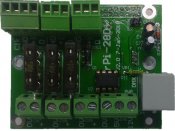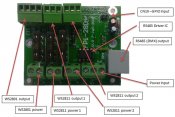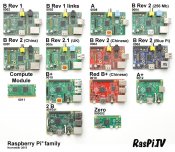The rPi-28D+ pixel and DMX cape for the Raspberry Pi is now available. It is essentially the same as the rPi-28D but with fuses for the 3 pixel outputs. The board is supplied with 3 7.5A ATO fuses but can be used with up to 10A fuses meaning that up to around 180-200 pixels per output can be powered at 100% brightness.
The boards are $AU38 including GST which works out to around $USD24.40 or £18.55. There is discounts for bulk quantities and they ship pretty near anywhere in the world.
http://www.hansonelectronics.com.au/product/rpi-28dplus/
-Supports 2 2811 pixel outputs
-Supports 1 2801 pixel output
-Supports 1 non-isolated DMX outputs
-Runs under Falcon Player (FPP)
-Has 75HC245 to level shift signals from Raspberry Pi 3.3V logic to 5V logic
-Can power cape and Raspberry Pi from 5V or 12V input
-Uncommitted connection to GPIO26 pin for external use. Powering down, starting show, changing sequence etc.
-Mounting holes to suit Pi 2, Pi 3 and Pi Zero
-Real Time Clock (RTC) for show scheduling
-Supplied with M2.5 Nylon spacers to separate the Pi and rPi-28D
-3 fused power inputs for the 3 pixel outputs. 5V , 12V and/or 24V pixels can be connected
-Supplied with 3 7.5A ATO automotive fuses
The boards are $AU38 including GST which works out to around $USD24.40 or £18.55. There is discounts for bulk quantities and they ship pretty near anywhere in the world.
http://www.hansonelectronics.com.au/product/rpi-28dplus/
-Supports 2 2811 pixel outputs
-Supports 1 2801 pixel output
-Supports 1 non-isolated DMX outputs
-Runs under Falcon Player (FPP)
-Has 75HC245 to level shift signals from Raspberry Pi 3.3V logic to 5V logic
-Can power cape and Raspberry Pi from 5V or 12V input
-Uncommitted connection to GPIO26 pin for external use. Powering down, starting show, changing sequence etc.
-Mounting holes to suit Pi 2, Pi 3 and Pi Zero
-Real Time Clock (RTC) for show scheduling
-Supplied with M2.5 Nylon spacers to separate the Pi and rPi-28D
-3 fused power inputs for the 3 pixel outputs. 5V , 12V and/or 24V pixels can be connected
-Supplied with 3 7.5A ATO automotive fuses




